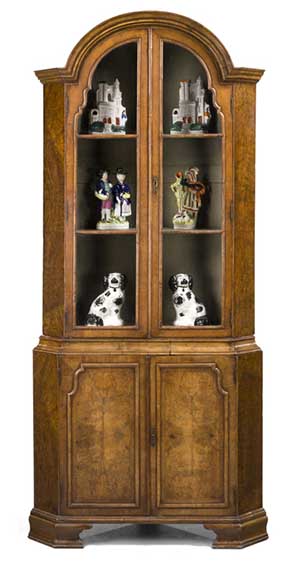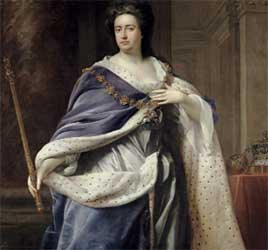Despite a short reign (1702-1714), Queen Anne bestowed her name to a fairly exquisite style of architecture and applied arts. Strictly speaking, the style started taking shape during the reign of Queen Mary and her husband, William III of Orange, and persisted for some time after Anna’s successor, George I, took the throne. Overall, its influence is noticeable throughout the first half of the 18th century.
The Queen Anne style flew across the ocean and had been a dominant force in the American colonies until the beginning of the 1800s. Overall, Queen Anne antiques display a transition from baroque to rococo. While early examples of furniture boast massive shapes, dramatic curves, and decorative details, later designs, especially those of American origin, became lighter, simpler, and more sophisticated.
About Queen Anne Antique Furniture

The period when Queen Anne was holding the British crown is associated with a shift both in aesthetic and innovation. It introduced new shapes, materials, finishes, and even gave importance to such an unheard-of thing as comfort. Below, we’re going to take a closer look at the features by which you can identify Queen Anne antiques.
Walnut Tree Supremacy
Sometimes this period in the interior design history is called ‘the age of walnut’. Prior to the turn of the18th century, oak remained a favourite material of English cabinetmakers. Solid, heavy, and sturdy, it was a perfect choice for the imposing furnishings of Tudor rooms. However, the new century brought new trends in interior designs. Rooms developed a penchant for romance, elegance, and lightness. These traits required a different material, and it was found in walnut.
Besides walnut, exquisite furniture benefited from maple and cherry woods; later designs used imported mahogany. Sometimes, furniture makers resorted to tricks to offer a piece that is strong and elegant at the same time. They would craft a frame from oak and designate softer wood species for decorative purposes.
Queen Anne Furniture Has An Emphasis on Comfort

It was during the reign of Queen Anne that furniture began to take on an anatomical shape. The high backs of chairs were made to accommodate the curve of the spine. Their shapes resembled silhouettes of violins and vases. Every furniture surface intended for sitting acquired padded upholstery. The statement textiles for upholstery were damask, corduroy, and wool.
One of the most iconic pieces created in the first half of the 18 century is a chair with a slotted vase-shaped back and a floral tapestry seat. The back with an almost anatomical curve was complemented with a carved splat, an element borrowed from Chinese furniture.
Cabriole Legs
Another prominent feature of that period’s furniture is cabriole legs displaying a double curve that repeats the shape of the letter S. These legs normally end with a pad foot or rounded designs that drew inspiration from claws or paws. Embellished with shell ornaments, graceful at the bottom and widening at the top, cabrioles remained pervasive throughout many other subsequent periods. As for Queen Anne furniture, you can see these eccentric legs not only in tables, chairs, and armchairs but also in highboys and beds, although on a smaller scale.
Cabriole legs are a key feature of this Queen Anne walnut stool. They smoothly transition into exquisite pad feet while carrying C-scroll spandrels at the top. The chair is crafted from the signature for this period walnut wood and finished with padded velvet upholstery.
New Types of Queen Anne Furniture
The Queen Anne style is associated with multiple innovations in furniture design. For example, the tradition of public tea-drinking induced the need for portable chairs and tables. To grant the request, furniture manufacturers came up with folding butterfly tables featuring folding side panels. The desire for comfort resulted in the invention of “cocoon” chairs offering padded seats and high backs transitioned into armrests. Due to the lush dresses that came into fashion in the beginning of the 18 century, women demanded more elegant solutions to store their clothes than chests. Furniture makers offered them exquisite dressers and dressing tables with mirrors for good measure. Another great example of improvements in furniture design is mirrors placed outside of the cabinet doors. The very first bookcases and secretaries were also constructed during the period named after Queen Anne.
Chinoiserie Style
The booming trade with Asian countries set a new trend in decorative techniques. In particular, it brought new exotic materials, patterns, and looks. The marine theme was especially popular. Upholstery textiles, as well as carved woods, offered a beautiful display of scallop shells, sea animals (including mythical ones), and marine plants.
Dramatic lacquered Chinese-style cabinets appeared in living rooms. They came with pagoda-like cornices and lavish paintings of landscapes, flora, and fauna. Other types of furniture also gravitated towards lacquer and gilding, as was customary in Asia.
Key Features of Queen Anne Antiques
Queen Anne furnishings and interiors on the whole radiate luxury, elegance, and playfulness. When it comes to more specific features to help you identify antiques of this period, they are as follows:
– An abundance of textiles: rich draperies, large carpets with fancy patterns, luxurious upholstery fabrics, decorative cushions, bedspreads, light canopies, etc. The textiles of choice are damask, tapestry, corduroy, chintz, and wool;
– wood is pervasive throughout interiors: wooden parquet, decorative elements, wall panels, and others;
– pilasters and stucco mouldings that showcase the impact of Greek and Roman cultures;
– symmetrically arranged decorative elements, proportional, and comfortable furniture;
– furnishings are embellished with moderate yet sophisticated carvings, marquetry (inlaid), mosaics, and finished with lacquer;
– common motifs include images of flora and fauna (the handles of dressers in the form of a bat look especially impressive), landscapes, jagged shells, curls, and oriental ornaments;
– a restrained and noble colour palette based on pastel shades;
– tall mirrors of impressive sizes;
– the obligatory attributes of the interiors are framed paintings, tapestries, heavy candelabra, as well as a fireplace featuring a lavishly decorated portal.
Queen Anne Revival Antiques
The reign of Queen Victoria saw the return of many historic designs, and the Queen Anne style was no exception. It happened around the 1860s in England, and a couple of decades later, Queen Anna revival reached The New World. According to the designer and architect Charles Eastlake, interiors subject to this trend are steeped in simple and straight lines and fewer embellishments compared to the original style.
Among other prominent features of 19th century Queen Anne furniture are:
– A tendency to angular shapes;
– curved pilasters and legs including cabriole legs;
– realistic but shallow carving and engraving;
– walnut and oak woods as leading materials for furniture manufacture.
Queen Anne revival antiques are striking in their own way. Yet, they have little in common with pieces created at least a hundred years before the revival phase. This makes it hard to organically blend two different styles named after Queen Anne in the same interior.

